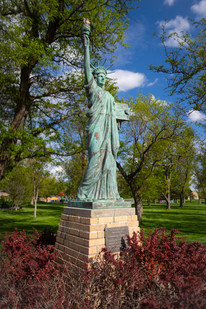Legendary Tales
- director9291
- Jul 25
- 2 min read
By: Kylie Johnson

Tucked away in the quiet corner of downtown Colby, just off Highway 24, lies one of our most beautiful, serene parks — Fike Park. This hidden gem is a gateway to family fun and childhood memories, from its interactive playground to the basketball and tennis courts, whimsical tree carvings, and the Santa City building.
In summer, the park hums with energy — laughter echoes, food truck aromas swirl through the air, and children race across the lush green grass. Whether a concert, festival, or parade, there's always something exciting unfolding.
When winter arrives, Fike Park turns into a holiday wonderland. Jolly Saint Nick's annual visit to Santa City invites families to share Christmas wishes, savor homemade cookies, and bask in the glow of twinkling lights.
Fike Park is a place where memories are made — but what’s hidden beneath the rubber clippings and lush bluegrass? Some locals speculate it’s built atop an Indian burial ground, but is that truth or myth?
Thomas County, once part of the “Great American Desert,” was officially established in 1880. Prairie grass stretched endlessly, a cowboy’s paradise filled with wild horses and roaming buffalo. But for early settlers, this untamed land was a harsh reality. With little water and few resources, their version of luxury was a far cry from the comforts of today.
Before the county's founding, stories told by settlers share gruesome accounts of Indian raids and encounters. In 1878, a band of Oklahoma Indians raided down Sappa Creek (north Thomas County), killing and looting. Among the victims, two Van Cleave daughters (from one of early Colby’s most well-known families) were captured, held overnight, and released on foot — stripped of everything.
Many stories claim deadly events for Indians occurred in the surrounding counties. Though there's no historical evidence of an Indian burial ground beneath Fike Park, some speculate it explains the rare tornado activity in Colby.
Despite these beliefs, Fike Park was truly once a cherished community lake. Records dating back to 1888 showcase Carp Lake (Fike Park) as one of the best amusement spots in Colby.
Originally a favorite spot for young individuals to boat or fish late in the evening, Carp Lake was said to have toads and frogs that could be heard from miles away singing people to sleep. Here, residents of Colby gathered around each Independence Day to watch as fireworks were lit off in the center of the island, reachable by a high boardwalk on 3-foot-tall stilts.
In 1907, the City of Colby saw potential in the often-dry Carp Lake, purchasing it with dreams of transforming it into a city park. By 1908, the vision was in full swing, with trees planted and land shaped. In 1919, the park was renamed Fike Park to honor James N. Fike, a former mayor and prominent farmer.
Over the years, it evolved, adding buildings and playgrounds, and becoming the backdrop for countless community events. Today, many gather around Fike Park for Picnic in the Park, Sunflower Festival and Food Truck Fridays.














Comments